Charles Alexander Newport
Sergeant 9515 Charles Alexander Newport, 5th Battalion, Royal Berkshire Regiment
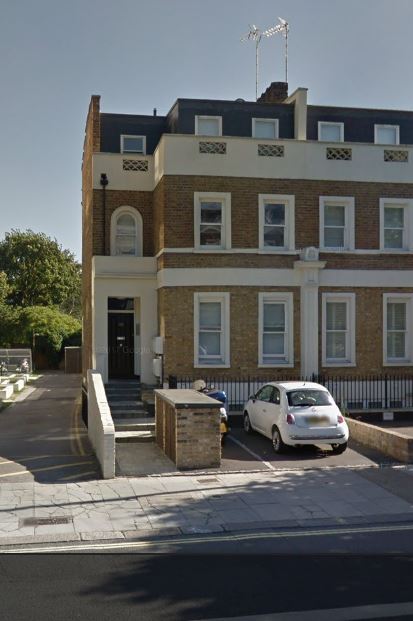
The family home was here at 103 Goldhawk Road from 1902-1904. |
Following Charles were six further children, five of whom are readily identified from census records: Stanley Richard (born 1895), Alice Elizabeth (1898), Elsie (1902), Thomas Emmanuel (1907) and Frank Edward (1909). The 1911 census included information on childhood survival – which showed that Charles and Emily had lost an child by that date. Tragically they were to lose another when Thomas died in July aged only four.
In 1900 the family was resident in Newbury, probably for no more than a few months, during which time Charles moved school from Thatcham to St Nicolas’ School in Enborne Road. He was only there for a matter of weeks (3 September – 22 October) before they moved on again. In 1902 young Stanley entered Wendell Park School in Shepherd’s Bush and the family lived nearby at 103 Goldhawk Road until, at least, August 1904.
At this time education was compulsory up to the age of 12 and commonplace to the age of 14; schooling beyond that age was the preserve of grammar and public schools. So Charles would almost certainly have left school by the time he was 15 and begun his working life. By 1911 he was working as a waggoner on a farm, probably the same farm that was employing his father (Thrupp Farm, Faringdon). However, he was not prepared to settle to life on the farm; on 12 June 1911 he enlisted into the Royal Berkshire Regiment. After his basic training he was posted to the regiment’s 2nd Battalion, then doing garrison service in India.
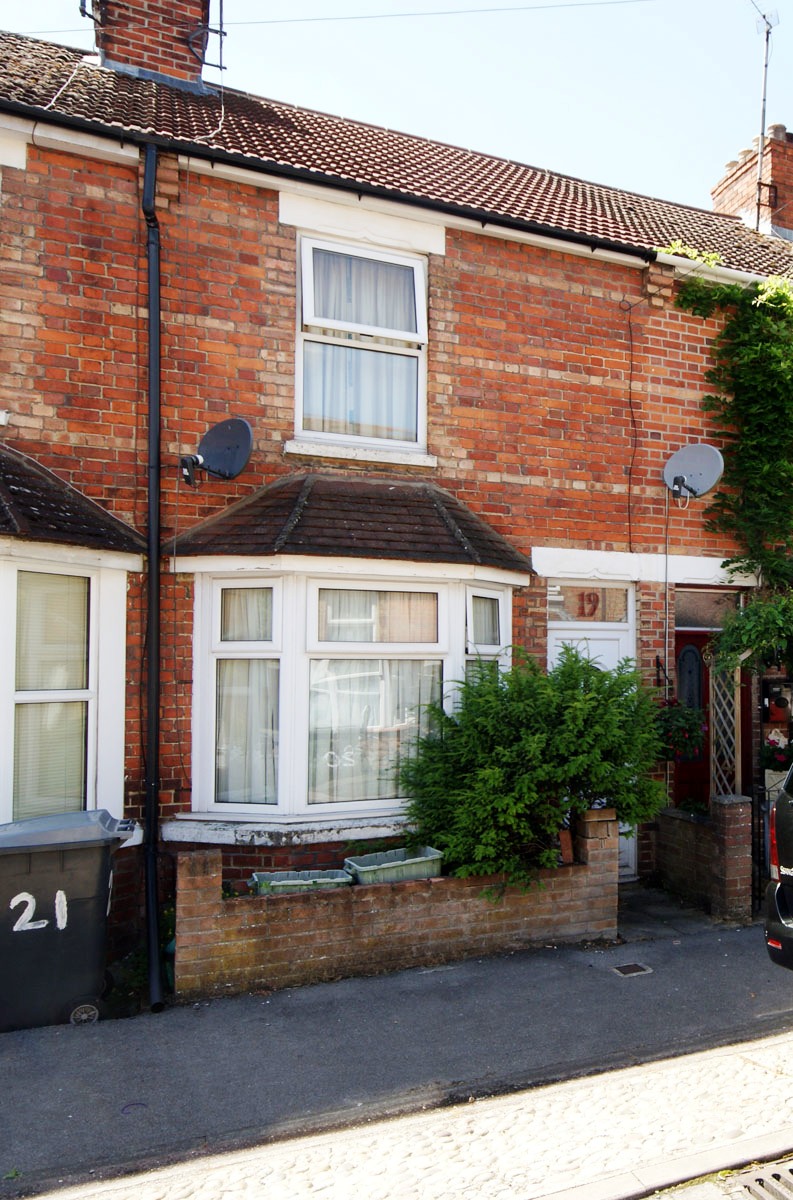
19 Connoaught Road the family home during Charle's time in uniform. |
When war broke out in August 1914 many units like the 2nd Royal Berks were recalled from their overseas posts (often being replaced by Territorial units) in order to swell the numbers of Regular soldiers in France. The 2nd Royal Berks landed at Liverpool on 22 October and proceeded to Winchester (Hursley Park) where the 8th Division was coming together, incorporating battalions and artillery returning from all parts of the British Empire. The 2nd Royal Berks became a part of the 25th Brigade and was brought up to strength by the addition of men from the Reserve.
On 6 November, only two weeks after its arrival at Liverpool the battalion landed again, this time in Le Havre.
After a hard winter spent in billets at Laventie and the trenches around Fauquissart the battalion saw its first major action at the Battle of Neuve Chapelle on 10 March 1915. This was the first British attempt to break through prepared German positions and, initially, things went well before descending into confusion and chaos. In the process Charles was wounded, his name appearing in a casualty list printed in the Berkshire Chronicle on 17 April.
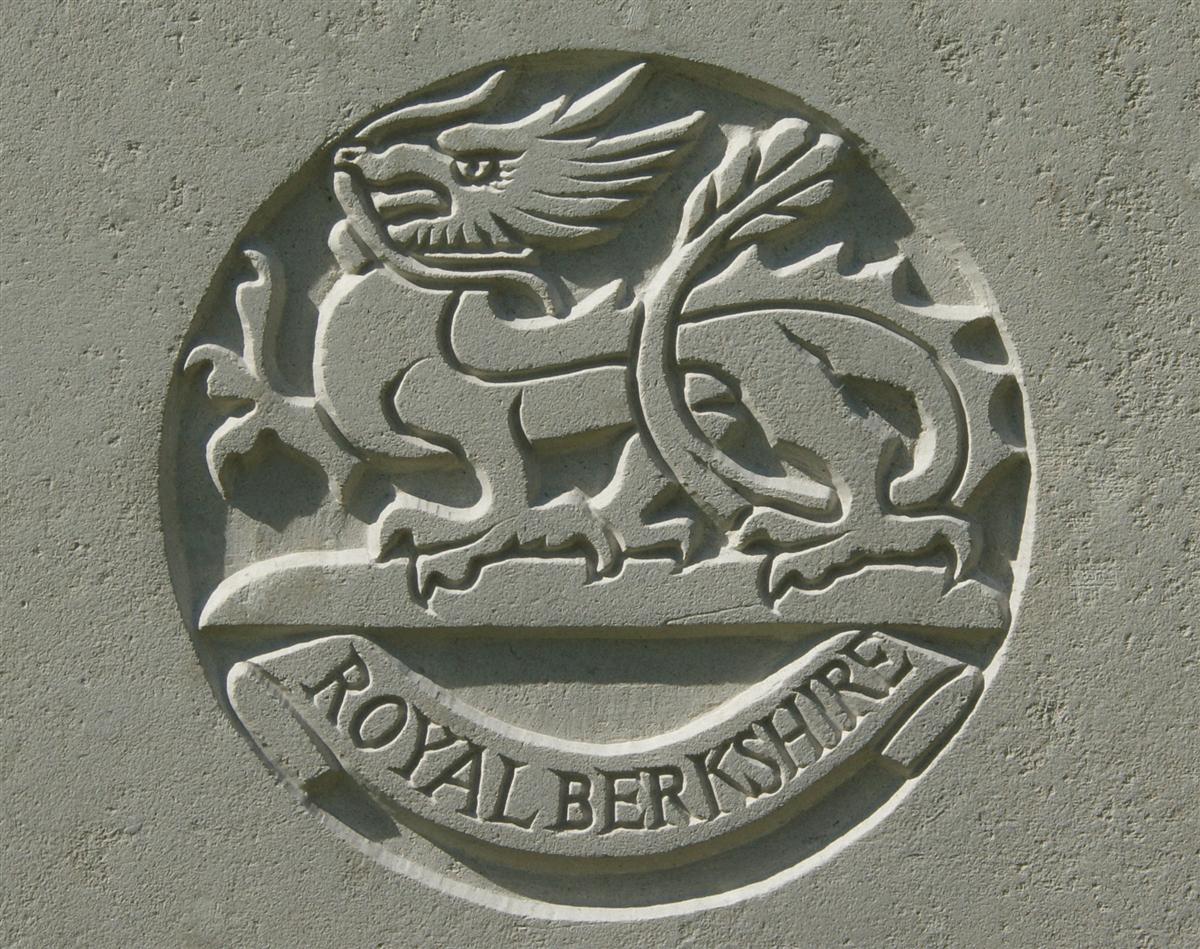
The regimental badge of the Royal Berkshire Regiment, as used on CWGC headstones. |
It seems that his wound may well have been serious enough to warrant a significant period in hospital and probably explains his move from the 2nd Battalion to the 5th Battalion. Most such transfers resulted from a break in service owing to wounds or sickness; when the man returned to active service he would be drafted to whichever battalion had the greatest need at the time.
He had evidently proved himself for he was promoted to the rank of sergeant. It is an old adage that ‘sergeants run the army, generals run the war’; it was then and remains today a key role – a leadership role in the field, not only ensuring the men of the platoon are doing what they should be, but very often also having to ensure that a teenage 2nd Lieutenant was doing what he should be.
On 9 April 1917 the British launched an offensive at Arras in support of French General Nivelle’s grand strategic offensive that was going to knock the Germans out of the war once and for all. Needless to say Nivelle’s plan failed in its overall aim and Nivelle was sacked – but there were successes, one of which was the opening of the British attack, especially at Vimy Ridge. However, as on so many previous occasions the offensive soon degenerated into small scale but extremely bloody assaults.
Having taken part in the opening of the battle the 5th Battalion, Royal Berks was taken out of the line for two weeks to reorganise and absorb new men who arrived to replace its losses (108 killed & wounded were replaced by two drafts totalling 128 officers and men).
On the evening of 25 April the battalion returned to the trenches, this time to the north of Monchy-Le-Preux. Three days later the 35th Brigade (including the 5th Royal Berks) went over the top again:
War Diary, 5th Battalion, Royal Berkshire Regiment – 28 April 1917
35th Bde received orders to capture BAYONET TRENCH, that part of RIFLE Trench still occupied by enemy and push out a line of outposts in advance of new line. Capture of BAYONET and RIFLE trenches allotted to 5th R Berks Regt on left, 7th Norfolk Regt on right, 7th Suffolk Regt being responsible for capturing 2nd objective, 9th Essex Regt, being in Brigade Reserve.
Dividing line between this Bn and 7th Norfolks I.31.a.0.6, I.31.a.6.7, I.26.c.1.8.
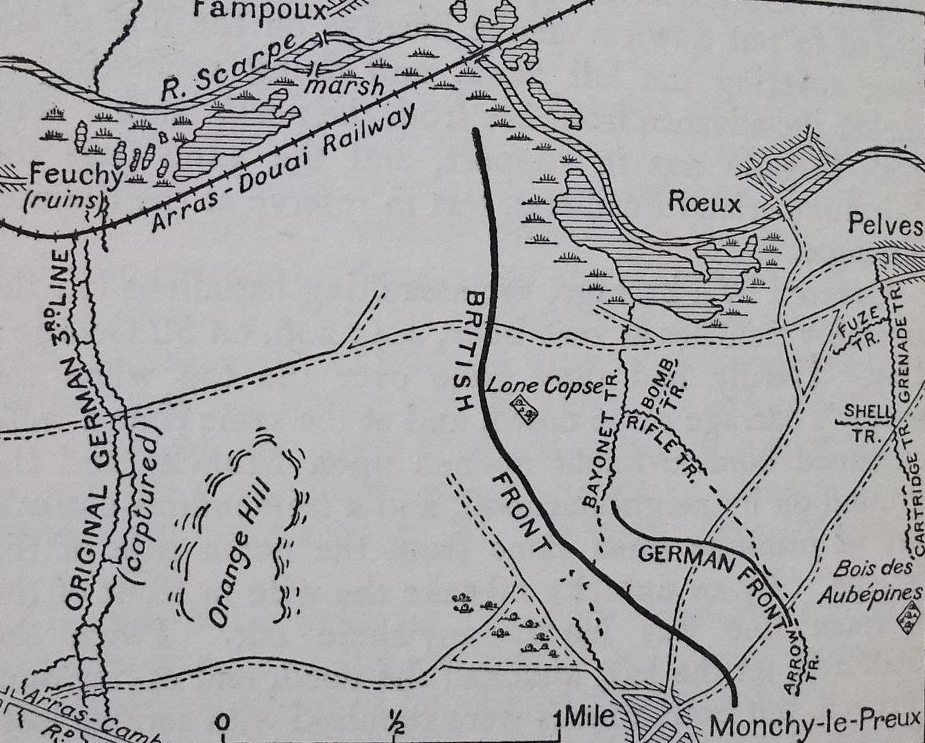
Sketch map of the ground the 5th Royal Berks fought over. |
The Battalion attacked at 4.25am on a three Company Front. C Coy on Right, D Coy in Centre, A Coy on Left – B Coy in Reserve.
All companies got close up under barrage and took their objective without difficulty – consolidating BAYONET and RIFLE trenches.
The 7th Norfolk Regt was not successful – and the 7th Suffolk Regt on going through us at Zero +50 min was met by heavy rifle and MG fire and could not get on.
The left company of this Battalion captured one machine gun, 1 officer and 16 other ranks prisoners.
At 9am. The situation was that this Bn held BAYONET Trench and RIFLE Trench as far as I.31.a.55.75 where a bomb stop was made.
The enemy occupied RIFLE Trench as far as HARNESS LANE. Position of 7th NORFOLKS and 7th SUFFOLKS unchanged.
One Company of 9th ESSEX Regt was attached to the Bn & came under the Commanding officer’s orders.
A year on the Berkshire Chronicle published a series of articles covering the local involvement in the battle, one of which covered this action:
Berkshire Chronicle, 8 March 1918 – 5th Royal Berks: German Trench Captured (extract)
The most severe trial for the 5th Berks came in holding the captured trench. Counter attacks were attempted, but with the splendid aid of the artillery the Berkshires stood firm and consolidated the captured ground. The German artillery fire was very heavy but the worst trials came owing to the failure of other units to take other portions of the trench on their right. The consequence was that in their captured position the Berkshires had to face a particularly concentrated aggregation of enemy fire. It was three days before the Berkshires were relieved and in that period they sustained about 200 casualties.
The same article reports a Corporal’s experience of that day, as included in a letter home:
Saturday morning my battalion had another smack at Fritz. It was worse than any fight I have yet been in. We simply knocked his lines off the earth and when the barrage lifted of his trench into it we jumped. He put up a show after, in counter attacks, but he cannot do much against our gunfire, it’s too awful. I had a most wonderful escape; part of my Company were in a very narrow piece of the captured trench and we were just waiting for a counter attack when something happened and I was thrown forward on my face.. The man next to me on one side was dying and on the other side my sergeant was dead. Beyond him the junior sergeant was lying badly wounded and I set to work to give him a dressing and then bound up my wound. The shell had apparently burst directly over or behind me and only caused slight damage to me. My rifle was blown to atoms. After about an hour I got back to the dressing station, but we had to run for it as Fritz sniped and then opened machine gun fire on us.
This was the day when Sgt Charles Newport lost his life, the corporal’s account above may well be describing the moment he died – according to the Commonwealth War Graves Commission he was the only Sergeant from the battalion who died that day. His remains were never identified, so his name is remembered on the Arras Memorial.
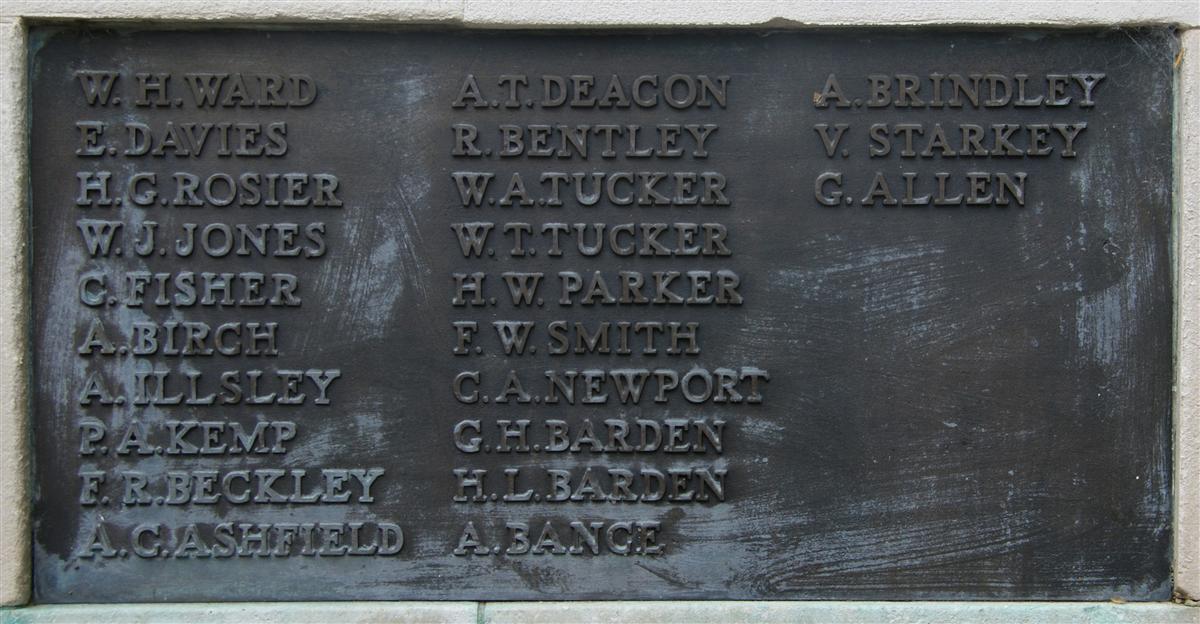
Charles' name on Newbury War Memorial (centre) |
Locally he is remembered on Tablet 6 of the Newbury Town War Memorial and was named on the roll of honour in St John’s Church (destroyed by a German bomb in 1943).
By the time the Newbury memorial was erected in 1922 the family were living in Thatcham, but they were still resident in Stroud Green when the World War memorial window was placed in St John’s Church in 1919, along with the roll of honour that included Charles’ name. It is thought that names from pre-existing church memorials formed the starting point when the names were compiled for the Newbury memorial.

